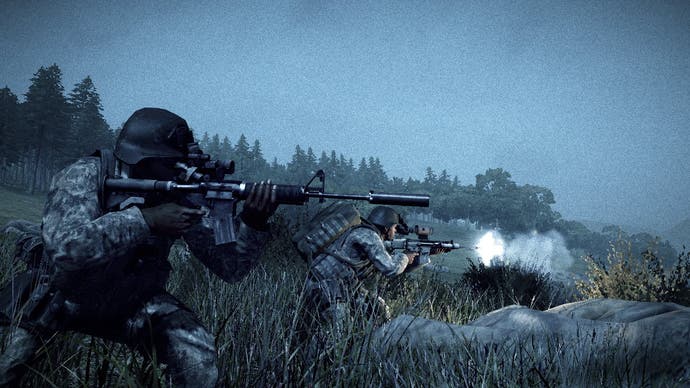Operation Flashpoint: Dragon Rising
War's a serious business.
Remarkably it's been eight years since the release of the original Operation Flashpoint: Cold War Crisis. The ultra-realistic tactical shooter veered drastically from the route the FPS was taking, aiming for hardcore realism and extreme difficulty in a gaming world that was about to ditch the ubiquitous medpack for regenerating health. Since then the original developer, Bohemia, has released an updated sequel, ArmA: Armed Assault, and is currently working on ArmA 2. In a much-publicised split, Bohemia retain the rights to make sequels, but publisher Codemasters has the rights to the game's name. Hence their unofficial sequel, Operation Flashpoint: Dragon Rising. Confused? Just forget about it all, and focus on being excited about what OPF:DR has to offer.
First and foremost, the scale of the game needs to be expressed. Dragon Rising presents a 135 square mile island, with an engine offering a draw distance of up to 35km. This isn't an exaggeration - we've seen it with our own eyes as a Cobra helicopter rises above the hills to reveal the extraordinary vista. The new engine is designed to allow a great deal of stuff on screen at any one time, which is essential for one of the game's most distinctive features: shooting people from miles away.
Most FPS games have your opponent invading your personal space before you're likely to dispatch them. In OFP you'll be wanting to take enemies out while they're still specs on the horizon, whether that's with your rifle, ordering your sniper, or maybe dropping a missile on their heads. Dozens of enemies on screen at once, while you're controlling up to forty men on your own side, miles apart: they had to build something impressively sturdy.

Rather than having set scripted missions, the freeform battles across the Island of Skira - contested by China and Russia, with the American troops sent in to capture the island for the Russians - instead depend on an AI Codemasters is extremely proud of. "Having an AI you can rely on to not be stupid, but to actually look after themselves properly makes a big difference," explains lead AI designer, Clive Lindop. "There are unnamed other titles - squad-based titles - where you're better off leaving them behind a dustbin and coming back at the end of the mission to get them, because they're a complete hazard to you. Whereas these guys - after a while you'll frequently forget they're there, because they're doing their job and you're not having to worry about them all the time."
The role you play appears impressively malleable. During the single-player game you're a commanding officer carrying a rifle, able to issue orders to your squad, as well as to larger groups of fellow soldiers as the scenarios require. This can mean playing hands-on, in the thick of the action, letting the AI worry about itself as you pursue goals. You have to be careful here, as the AI is constantly judging your actions, and if it thinks you're a loony, your troops will abandon you. Or you can station yourself at the top of a hill and order your troops into action on the fly, using the quick-command system. This is a series of threaded menus that appear on screen, rapidly flicked through to find the required option. "It's pretty handy," says Lindop. "It's designed in such a way so people would have the same muscle memory you'd get from a collection of keyboard commands. It has a couple of layers, and it's context-sensitive, so when you get used to using it, you even stop reading what it says."

The farthest extreme lets you choose to play completely from the game's command map, based on real-world Blueforce Tracker technology. Information your troops are able to see is reported on the map, and you can issue orders, orchestrate attacks, and generally play Napoleon without even seeing the real world. Of course, without your own eyes you're risking inaccurate information or out-of-date information from your men on the ground, but it demonstrates the versatility of the game.
Codemasters' aim for the game is to create a balance between the ultra-realism for which the original was famous, and creating an evocative simulation of being involved in a war. This extends from intricately accurate physics, right down to different bullet calibres making different sounds as they pass your ear, penetrating objects to appropriate depths. A column of smoke after a missile is dropped on a building gradually drifts away as the breeze carries it, while the resulting concrete dust billows and spreads below. Get caught in it and you'll have trouble breathing, and maybe even collapse.


